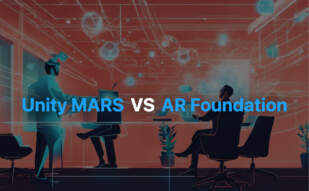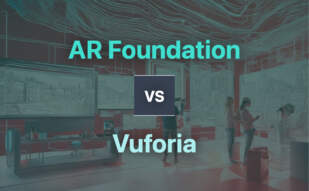AR Foundation is Unity’s premier cross-platform framework for building augmented reality experiences. Supporting Android and iOS, it requires Unity 2019.4.3f1 or later and provides essential AR features like Cloud Anchors, Camera configuration filters, and more.
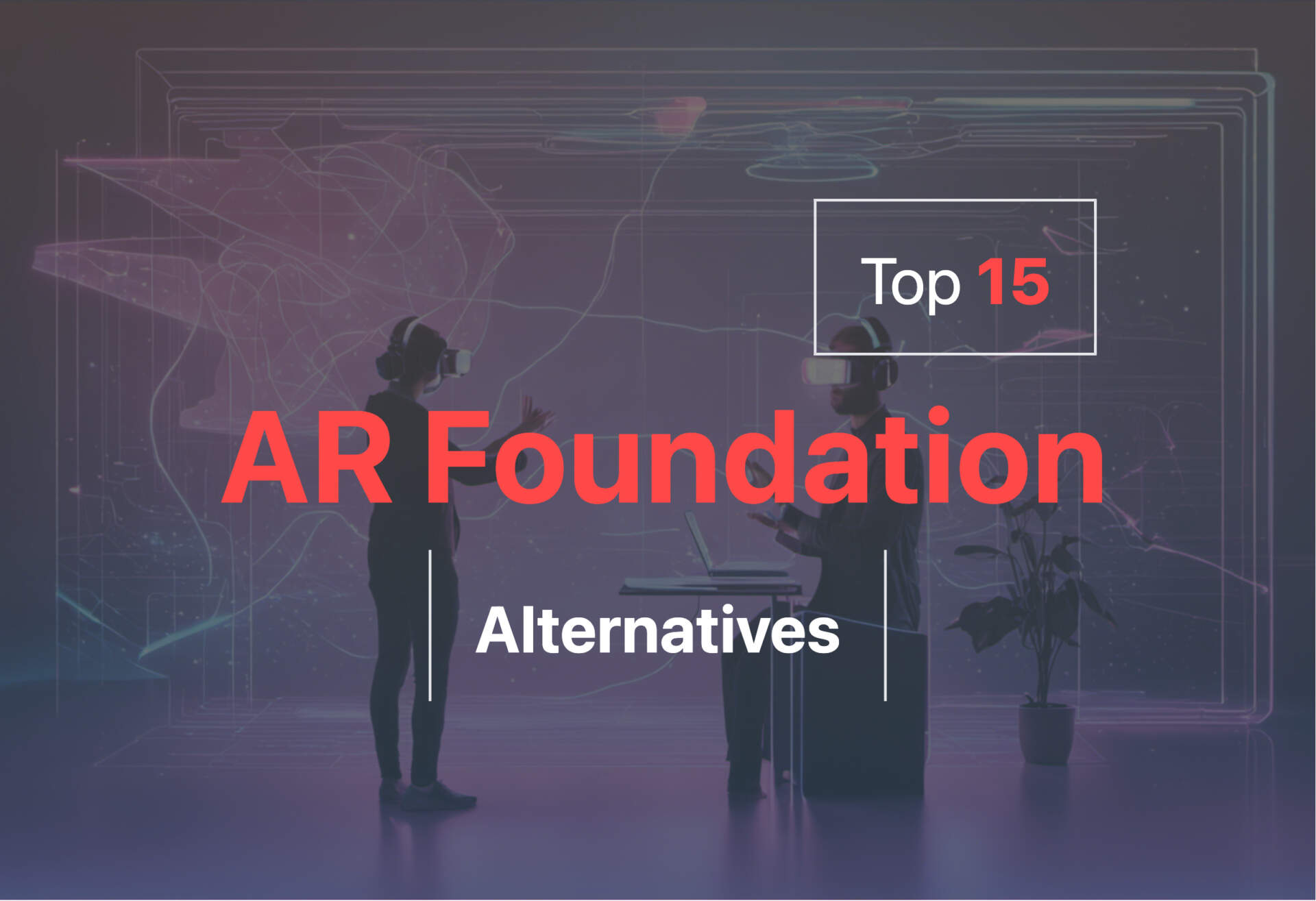
For individuals exploring substitutes for AR Foundation, potential alternatives encompass Unity MARS, ARCore, Vuforia, Sceneform, Zappar, Augment, Wikitude, Camera IQ, JigSpace, Adobe Aero, 8th Wall, Blippar, BUNDLAR, ZapWorks.
Unity MARS
An augmented reality (AR) creator tool, Unity MARS brings your AR visions to life with minimal coding and rapid iteration. It’s an integral part of the Unity Pro, Unity Enterprise, and Unity Industry packages.
Unity MARS Top Features
- Specialised AR tools and workflows: designed especially for AR developers, easing the app creation process.
- Plain-language authoring: reduces the need for extensive coding.
- Environment support: compatible with iOS, Android, and HoloLens platforms.
- Proxy-based workflow: facilitates easy framework creation.
- Simulation environments and customizable building blocks: aid in effective AR app testing.
| Unique Features | Benefits |
| Fuzzy Authoring, Responsive Visual Authoring, Smart Real-world Recognition | Eases the development of responsive, location-aware AR experiences. |
| Integration with real-world environment and sensor data | Delivers context-aware, responsive features. |
| Rapid simulation system | Speeds up AR experience iteration during the app development process. |
Unity MARS Limitations
- Demanding an annual fee after a 45-day free trial period.
- Requires existing Unity software for use with any subscription tier.
- Only supports Unity versions 2019.4 LTS and above.
Unity MARS Pricing
Unity MARS is free for the first 45 days. Thereafter, it costs $50/month or $600/year per license.
Unity MARS Use Cases
Use case 1
Creating responsive, location-aware AR experiences for iOS and Android mobile game development.
Use case 2
Building interactive simulations that leverage real-world environment and sensor data.
Use case 3
Fuzzy authoring method simplifies AR frameworks, ideal for many early adopters such as Sugar Creative in AR and VR app development.
ARCore
Emerging as one of the pioneers in the realm of Augmented Reality, ARCore is infused with Google’s technological prowess. It employs revolutionary APIs for a superior AR experience on both Android and select iOS devices. Let’s delve into the capabilities of this dynamic platform.
ARCore Best Features
- Superlative motion tracking for seamless AR interaction.
- Exemplary environmental understanding to mold AR experiences.
- Effective light estimation to amalgamate virtual with real.
- Expansive compatibility spanning Android 7.0 (Nougat) and up.
| Geospatial API | Depth API |
|---|---|
| Integrates Google Maps to elevate AR experiences. | Leverages terrain data for enhanced depth measurements up to 65m. |
| Employs Streetscape Geometry for a 3D mesh within a 100m radius. | Scene Semantics API employs AI for a detailed outdoor label. |
ARCore Downsides
- Compatibility issues with Google Maps live view.
- Unauthorized installation of Google Apps raised user concerns.
ARCore Pricing
ARCore offered by Google is an open-source platform, grasping AR’s creative potential without a monetary investment.
ARCore Use Cases
Use case 1: Game Development
ARCore acumen for real-time environmental understanding and superior motion tracking massively boosts the realm of game development.
Use case 2: Building Interactive Experiences in Apps
ARCore empowers developers by infusing enhanced user interactivity in existing as well as newly developed applications.
Use case 3: Geospatial augmentation in Mobile Applications
ARCore’s geospatial and depth APIs deliver an unmatched way to centralize location-based services to a whole new level in mobile application development.
Adobe Aero
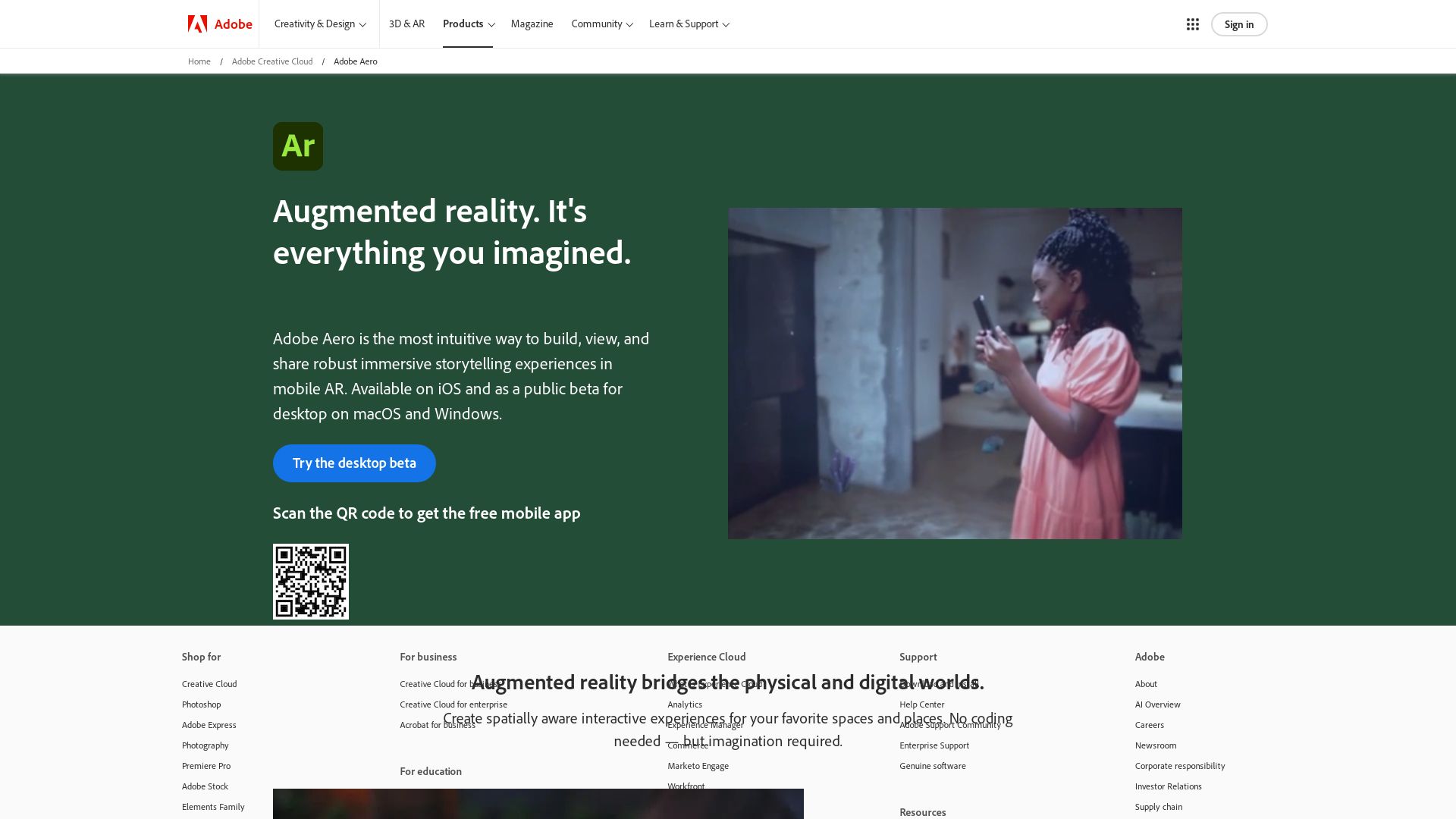
In the realm of Augmented Reality (AR), Adobe Aero has emerged as a user-friendly creation tool. Requiring no coding or 3D design expertise, it integrates seamlessly with Adobe Creative Cloud applications like Photoshop and Illustrator and is aimed at crafting real-world AR experiences.
Adobe Aero Top Features
- Intuitive gestural commands for asset placement, rotation, and scaling.
- Creation of interactive experiences with behavioral content triggers and object motion paths.
- A preview mode that visualizes edits, tests interactions, and records progress via video snapshots.
- Supports App Clips for quick loading experiences sans Aero app installation.
- Viewer mode allows interaction with the creation, with changes publishable through the originally shared link/QR code.
- Routinely updated for performance and stability enhancements; compatible with iOS 16+.
| Integration | Adobe Photoshop, Illustrator, and other Adobe Creative Cloud applications are supported for content input. |
| Sharing power | App Clips support eliminates the need for Aero app installation, resulting in faster loading experiences. |
| User Experience | While there may be some limitations and bugs, overall user appreciation is high. However, an issue with the app’s audio on social media uploads has been identified. |
Adobe Aero Limitations
- Exclusivity to iOS devices restricts the user base.
- Lacking some advanced features observed in other AR platforms.
- There have been reported cases of project failure to open, necessitating the importance of frequent backups.
Adobe Aero Pricing
At present, the financial details for Adobe Aero have not been divulged.
Adobe Aero Use Cases
Use case 1 – Artists
Adobe Aero offers an intuitive and simplified AR development tool, making it an ideal gateway to augmented creativity for artists.
Use case 2 – Educators
Educators can also leverage Adobe Aero, utilizing its AR capabilities to enrich their teaching mediums and stimulate student engagement.
Use case 3 – Marketers
With its easy-to-master interface and sharing capabilities, marketers can use Adobe Aero to create interactive prototypes and frequently update content for targeted campaigns.
8th Wall

Born in the tech hub of Palo Alto, 8th Wall is a pioneering force in the realm of augmented reality (AR). The award-winning platform from Niantic Inc. enables the creation of immersive, web-based AR experiences, making AR accessible to users across the globe through just a smartphone. Its technology has powered more than 2000 commercial experiences since 2019 and helped establish the real-world economic values of AR.
8th Wall Top Features
- Computer Vision SLAM System: Introduced in 2018, this system facilitates accurate WebAR experiences by integrating with the viewers’ surroundings.
- 8th Wall’s Cloud Editor: A robust, cloud-based integrated development environment for WebAR/VR with integrated source control, live previewing, and more.
- 6-DoF Tracking: Offers six degrees of freedom, enabling objects to move freely in 3D space.
- New Hand Tracking Feature: Provides 36 attachment points across fingers, palm, and wrist, opening new dimensions in “Human AR.”
- AR Code: A user-friendly platform using AR QR Codes for anchoring and accessing AR content.
| Feature | Description |
|---|---|
| Lightship VPS | Enables indoor and outdoor global positioning without GPS. |
| Face Effects | Allows developers to alter human appearance through devices with features like iris tracking and multi-face support. |
| Sky effects | Identifies and segments the sky into a canvas for AR content. |
8th Wall Limitations
- Requires Understanding of Web Technologies: Developers have to understand JavaScript, WebGL, and HTML5 to create AR experiences.
- Higher Commercial License Cost: The license can exceed 2000 USD per month, which may not be suitable for all budgets.
- No Compatibility with Apple Vision Pro Headset: The platform is based solely on webAR technology.
8th Wall Pricing
The commercial license for 8th Wall is a considerable investment, exceeding 2000 USD per month, making it a premium choice for AR development.
8th Wall Use Cases
Retail
Retailers can enhance their shopping experience by using 8th Wall’s hand tracking feature to give customers a virtual try-on facility for accessories like rings, watches, and bracelets.
Gaming
Game developers can ramp up player immersion by leveraging 6-DoF tracking and hand tracking to help players interact with virtual objects in more realistic ways.
Education
Educators can create engaging, visual-based learning modules that use AR to make complex concepts more understandable and appealing to students.
Blippar
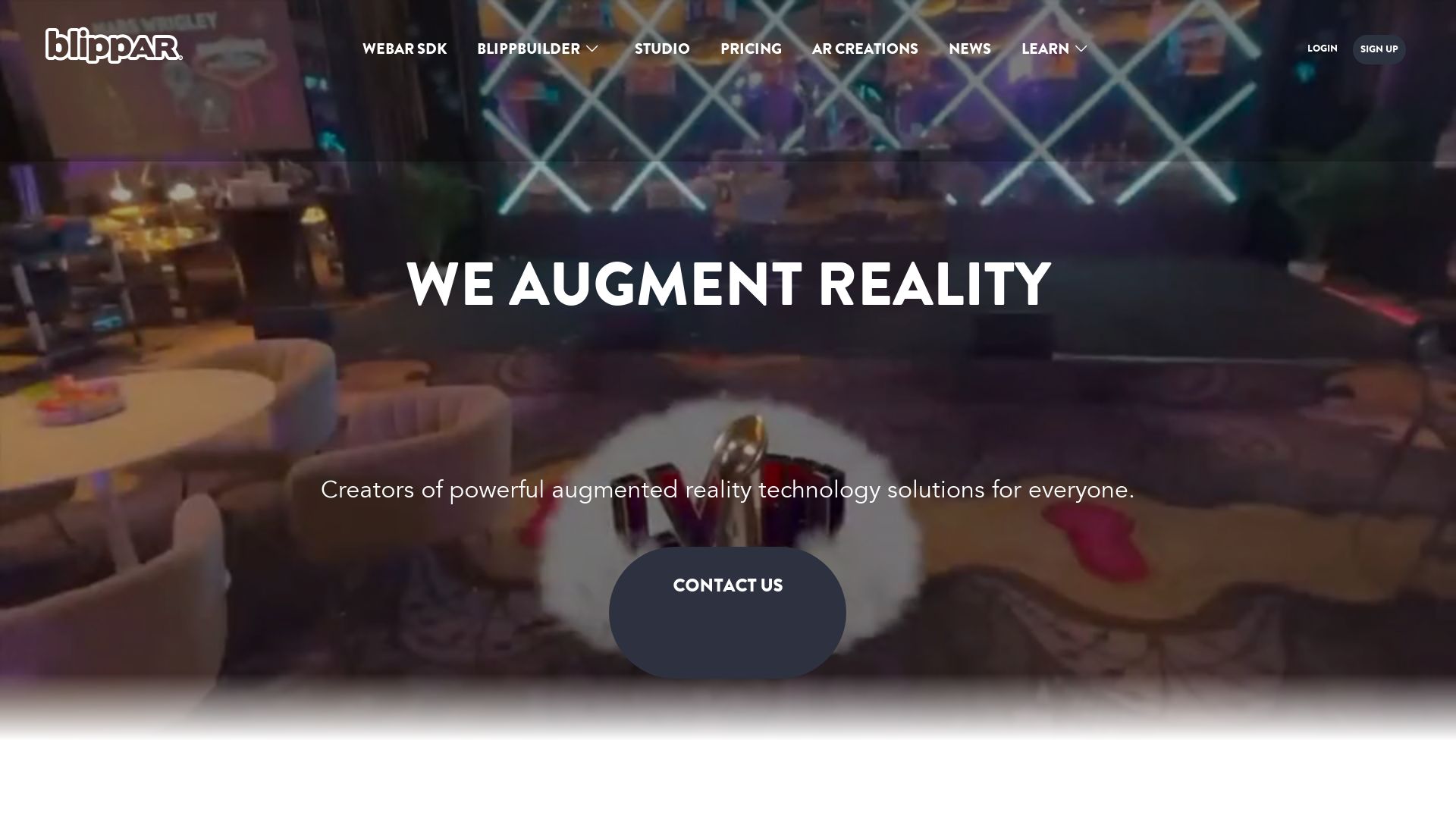
Established as UK’s first tech unicorn, Blippar specializes in AR content creation and publishing. Having partnered with industry juggernauts, it has been recognized for its groundbreaking AR products and services, making it a game-changer in the Augmented Reality market.
Blippar Top Features
- AR Content Creation: Offering state-of-the-art tools and platforms for creating augmented reality content.
- No-Code AR Creation: With the free-to-use Blippbuilder, no coding experience is needed to develop AR experiences.
- Recognition Technologies: Innovates with facial and car recognition technologies, facilitating a wide-ranging utility for businesses.
| AR for Advertisers | Initially providing smartphone-based AR technology for advertisers, Blippar offers a unique avenue to reach audiences. |
| Location-Based AR | Offers geographical context to AR experiences, opening up a new layer of interactivity and personalization. |
| Visual Search Engine | Using AR to unveil a new way of discovering and searching the physical world around us. |
Blippar Limitations
- Despite offering a wide range of features and tools, Blippar hit financial trouble in 2018, leading to insolvency proceedings.
- The pivot from AR experiences to an SaaS platform was deemed a necessity rather than a choice, an indication of potential unpredictability.
- Complexity and specialization may pose a hurdle for beginners in the AR scene.
Blippar Pricing
Blippbuilder, the no-code AR creation tool, is free-to-use for all. No specific pricing details available for advanced business solutions.
Blippar Use Cases
Use case 1: Advertisers
Advertisers can leverage the power of Blippar’s AR advertising technologies to bring interactive, engaging campaigns to life. It offers unique customer engagement leveraging AR and object recognition tech.
Use case 2: Businesses
With AR technologies such as facial recognition and location-based AR, businesses can adopt innovative ways to interact and capture customer interest.
Use case 3: Developers
Blippar’s Blippbuilder, the no-code AR tool, allows developers to swiftly create and deploy AR experiences, even with limited coding skills.
BUNDLAR
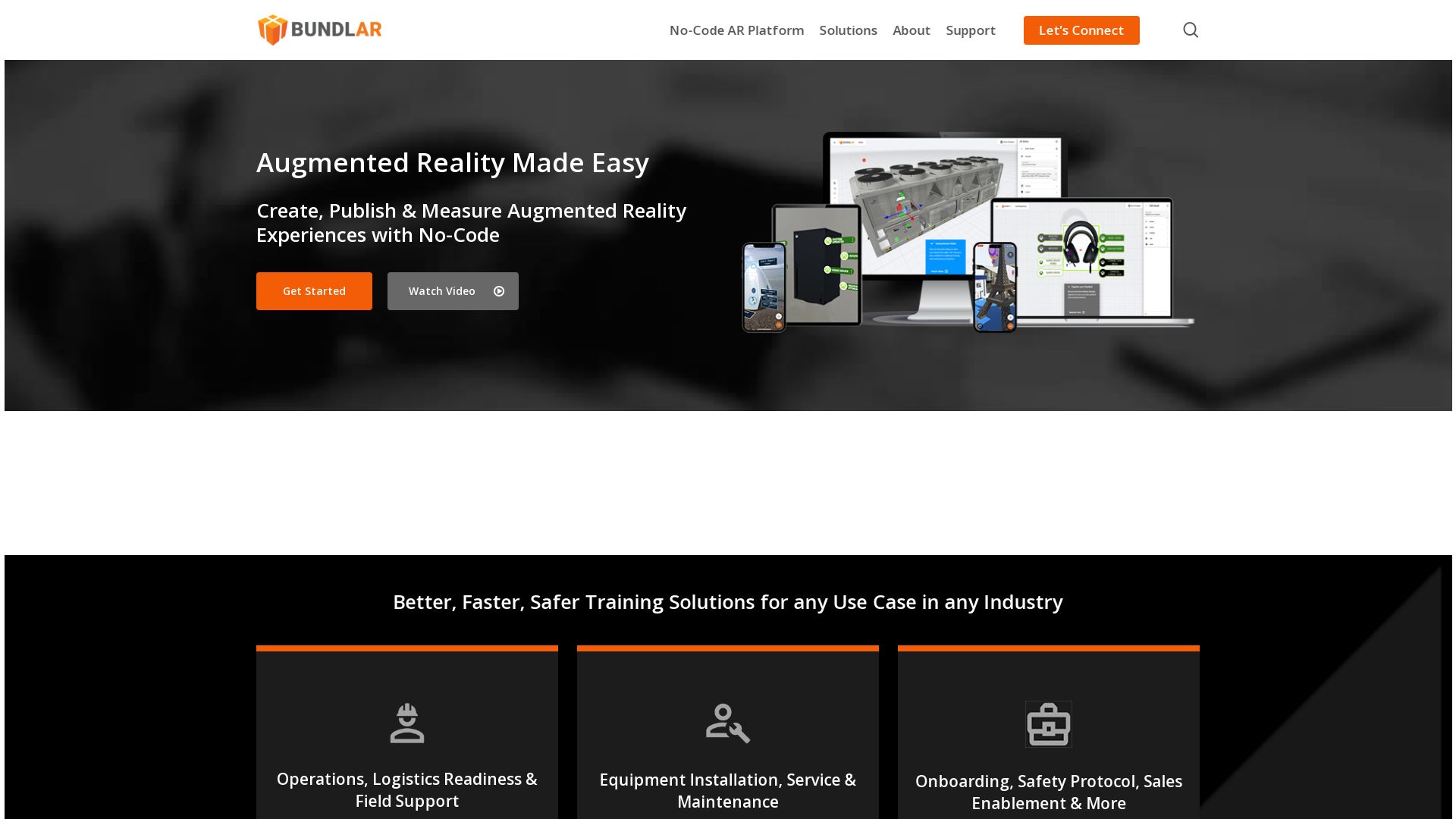
Meet BUNDLAR, a cutting-edge, sustainable Augmented Reality (AR) platform designed to support operations, logistics, safety protocols, and more. With its cloud-based ‘bundling’, no-code solutions, and robust analytics dashboard, BUNDLAR provides a powerful, yet accessible toolset for AR experiences.
BUNDLAR Top Features
- No-code solution: A drag-and-drop interface makes creating AR experiences a breeze.
- Real-time Measurement: Track, optimize, and measure ROI through a comprehensive analytics dashboard.
- Cloud ‘bundling’: Secure, stable, and reliable AR experiences supported by state-of-the-art cloud technology.
- CMS Customization: Meet project requirements with a CMS that allows for effortless customization methods.
- Diverse Applications: Apply AR from operations to sales enablement, expanding the horizons of digital innovation.
| Integration | Deployment |
|---|---|
| Seamless integration with third-party software like Microsoft Office 365, Salesforce, Zendesk. | Deploy AR experiences both via the BUNDLAR app and other AR applications with unique branding. |
| Editing Post-deployment | Platform Tiers |
| AR technologies and experiences can be modified post initial launch. | Different plans catering to professional, enterprise, and federal requirements. |
BUNDLAR Downsides
- Restricted Compatibility: Requires iOS 12.0 or later for compatibility.
- Privacy Concerns: Collects & links location, contact info, identifiers, usage data.
BUNDLAR Pricing
The pricing is project-dependent with different plans for professionals, enterprises, and federal needs. Additional information related to pricing would need to be obtained from BUNDLAR.
BUNDLAR Use Cases
Use Case 1: Sales Enablement
BUNDLAR’s AR experiences can equip sales teams with virtual demonstrations or presentations, enhancing customer engagement and driving sales growth.
Use Case 2: Logistics
Logistic operations can reach new heights with BUNDLAR’s AR solutions, offering visual guidance for locational logistics and real-time tracking.
Use Case 3: Employee Onboarding
With BUNDLAR, industries can digitalize their training and onboarding with interactive, captivating AR experiences, reducing training time and increasing effectiveness.
ZapWorks
A global leader in the field of augmented reality, ZapWorks takes center stage with its wide array of AR tools and features. Its flexible development environments, exhaustive AR creative suite, and user-friendly platforms make it a hot favorite among designers, developers, and marketers alike.
Top Features of ZapWorks
- WebAR experiences: A robust platform for creating standout WebAR experiences using no-code, low-code, and custom code options.
- AR Content Creation: Using Zapworks Studio, authors can enjoy the best of a visual UI and a flexible code editor.
- Multiple Tracking Types: Includes world tracking, face tracking, and image tracking for a comprehensive AR experience.
- Enterprise Deployment: Offers branding, hosting, priority support, and security for enterprise-scale applications.
- Integration with ARKit & ARCore: Import 3D models, characters, scenes from Sketchfab for cloud-based AR experience creation.
| ZapWorks Studio 6 | Focuses on lowering tech-barriers and enriching short-form mobile content creation. |
| Face Tracking | Tracks multiple faces with 3D mesh for feature-rich facial animations. |
| Specialist AR Training | Offered to maximize the impact and effectiveness of AR experiences. |
ZapWorks Downsides
- UX is considered less than ideal with claims of limited creative freedom.
- Some features such as world tracking and cylindrical tracking for WebAR reportedly have limitations.
ZapWorks Pricing
ZapWorks has varied pricing strategies for personal, business, and educational usage, as well as for app embeds. The actual cost can be ascertained based on usage requirements.
ZapWorks Use Cases
Use case 1—Education
ZapWorks offers an interactive way of enhancing classroom learning and training programs through AR. By creating immersive and engaging content, it heightens the learning experience.
Use case 2—Product Prototype
ZapWorks enables leading brands to prototype products and drive innovation, providing invaluable assistance throughout the product development journey.
Use case 3—Marketing and Sales
ZapWorks amplifies marketing and sales efforts by providing an interactive, engaging way to showcase products, special offers, and branding content.
Vuforia
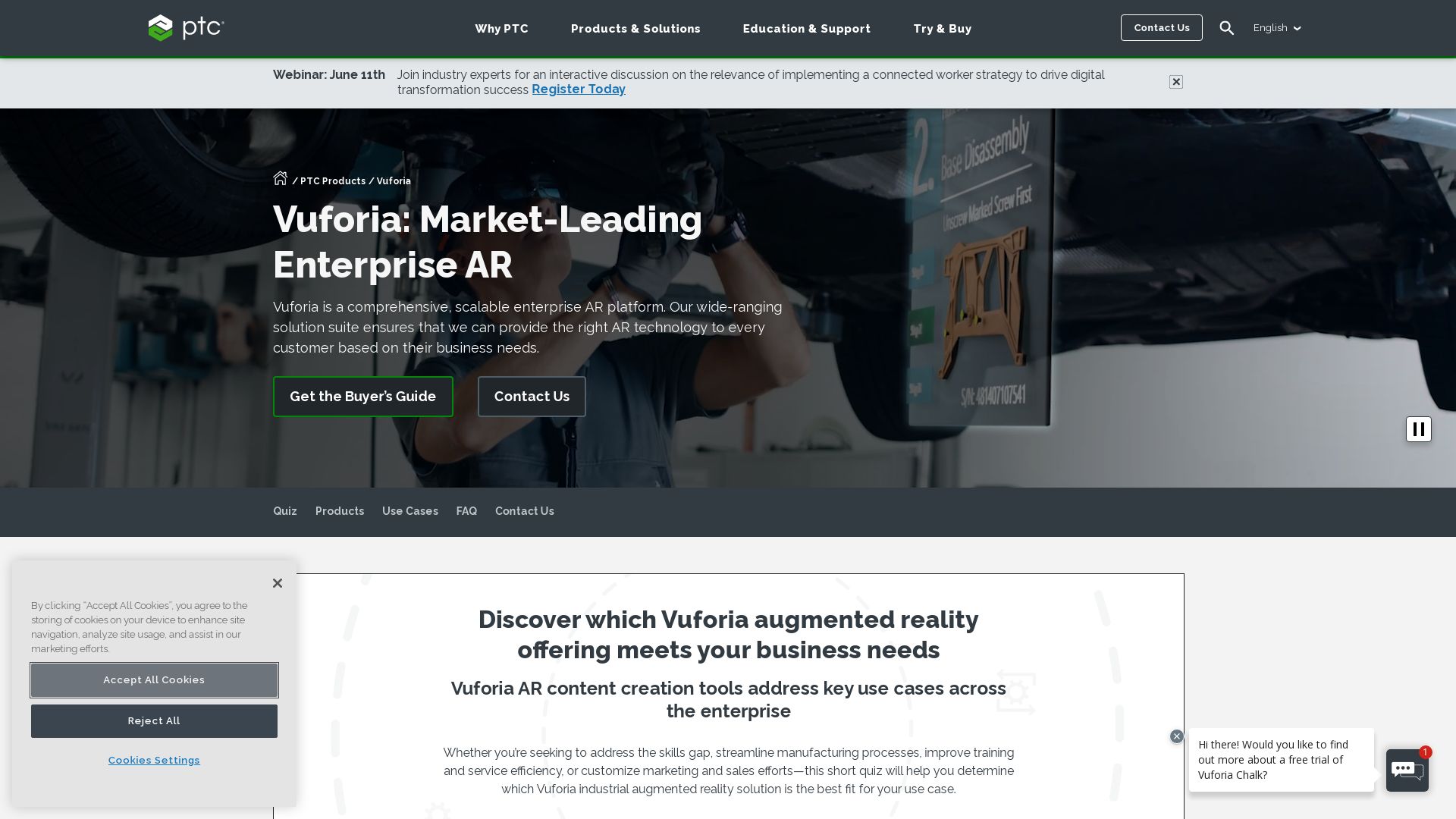
Born in the stables of Qualcomm, and nurtured to potential by PTC Inc., Vuforia presents itself as a leading contender in the realm of AR software development kits (SDK). Unlatching the doors to unprecedented reality augmentation, this engine leverages advanced computer vision technology for object recognition, hence enabling the creation of intricate and intuitive AR applications.
Vuforia Top Features
- 6 DOF device localization: This allows for realistic and immersive interaction with virtual content.
- Runtime Image Target Selection: The flexibility to choose image targets on the go.
- Highly Compatible: Runs seamlessly on iOS, Android, UWP and has API support for a multitude of languages.
- AR Digital Twin Technology: For stellar real-time overlays on real-world objects.
- VuMarks: A step beyond the conventional, VuMarks allow for dynamic object recognition and offer creative empowerment.
| Support Platforms | Unity, Android Studio, Visual Studio, XCode |
| AR Headset Compatibility | HoloLens 1, Microsoft HoloLens 2, Magic Leap, RealWear HMT-1, Vuzix M400 |
| Latest Versions | 10.18, including performance enhancements and bug fixes. |
Vuforia Downsides
- Deprecation of Virtual Buttons: This popular feature is set to be removed in future versions.
- Limitations with the free tier: Certain premium features such as Model Targets, Area Targets and Barcode Scanner are not available in the free tier.
- Cloud add-on overage charges: Additional cloud recognitions are charged at the standard rate of $0.01 per recoil.
Vuforia Pricing
Vuforia offers a range of packages tailored to every stage of an AR journey. The Develop license comes free, designed for learning and non-commercial use. The Basic plan allows for unlimited app development and publishing, along with a suite of features, whereas the Premium plan extends the limit to a broader set of features and applications. Confluence on the cloud? No worries! The plans can be extended with a cloud license or the more robust Cloud Plus add-on.
Vuforia Use Cases
Use case 1: 3D Product Demos
Vuforia’s AR prowess brings products to ‘virtual’ life, offering customers a rich, interactive and edifying buying experience.
Use case 2: Interactive Campaigns
With Vuforia’s dynamic VuMarks and extended tracking capabilities, marketers can script immersive campaigns that engage and inspire.
Use case 3: Gaming
Incorporating Vuforia’s rich set of features into your games could translate to more engaging gameplay and visually stunning AR experiences.
Unity

Launched in 2005, Unity breathes life into the artist’s vision, empowering developers with its potent rendering technology for creating 3D and 2D games, augmented reality, and a diverse array of applications. Its cross-platform adaptability and rich asset store form a harmonious foundation for creativity, offering an active community of like-minded creators.
Unity’s Best Features
- Adaptable with various operating systems, fostering an ambience for creating a myriad of applications from AR to 3D simulations.
- An all-encompassing suite of integrated tools, rendering technology, and features that enable high-quality game creation.
- A vibrant and active developer community encouraging assistance, problem-solving, and system improvement feedback.
- A plethora of coding languages including BOO script, JavaScript, and C# to pave the path for diverse programming creativity.
- Its evolution embodies an unyielding quest for user-friendliness, compatibility, and immersive visual experiences.
| Features | Benefits |
|---|---|
| Highly adaptable | Suited for diverse game development needs |
| Rich Asset Store | Empowers developers with pre-designed textures and features |
| Continuous technological evolution | Promotes compatibility and immersive visual experiences |
Unity Downsides
- Recent unannounced pricing changes eroded developers’ trust, causing concerns about financial sustainability.
- The new per-install fee structure sparked backlash, being viewed as especially harmful to solo, indie, mobile developers.
- Potential abuse of per-install fees, especially due to repeated downloads by a single user, causes unease among developers.
- Developers fear the impact of these changes on digital preservation efforts.
Unity Pricing
The Unity pricing model is set for a transformation on January 1, 2024. Developers will be asked to pay a fee each time a game using Unity software is installed. However, the website reassures users that developers will only be charged an install fee once their game reaches $200,000 revenue and surpasses 200,000 installations. Fees apply only to activity post-January 1, 2024, with higher fees for markets like the US and the UK.
Unity Use Cases
Use case 1: Augmented Reality Creations
Unity’s cross-platform adaptability and true-to-life rendering technology make it an ideal engine for crafting captivating AR content.
Use case 2: 3D Simulations
Whether envisioning a virtual reality experience or creating a 3D simulation, Unity’s rich suite of tools and features ensures your imagination is never restricted.
Use case 1: Mobile Games
With a strong focus on mobile games, Unity empowers developers with a streamlined process, spanning from idea conception to platform launch, optimized perfectly for the mobile canvas.
Sceneform
Developed by the world-renowned tech giant, Google, Sceneform is a specialized 3D framework created to streamline the development of mobile-optimized augmented reality (AR) applications.
Sceneform Top Features
- Flexible API Support: Sceneform provides APIs for loading and rendering 3D models that empower developers with AR Required and AR Optional application development capabilities.
- Dynamic 3D Model Creation: Equipped with the ability to create shapes like squares, cubes, and cylinders dynamically during runtime, Sceneform eases AR session management.
- Augmented Faces Functionality: Sceneform’s SDK includes Augmented Faces feature, which detects faces, generates mesh representations, identifies facial landmarks, and positions textures or 3D models based on the face mesh.
- Feature-rich AR Experiences: With Sceneform, developers get the power to incorporate AR features such as object scaling, object rotation, moving 3D models, and even capturing and saving a video of AR experiences.
| Feature | Description |
|---|---|
| ARCore Functionality | Sceneform leverages Android’s ARCore to track images being captured by the camera, facilitating video playback management. |
| Advanced 3D Rendering | Sceneform expedites the rendering process of 3D scenes, manages playback lifecycles, handles errors, and uses AR overlays based on the face mesh’s center. |
Sceneform Limitations
- Device Compatibility Issues: Sceneform SDK experiences certain compatibility issues with certain devices.
- Constraints in 3D Model Creation: Yet another limitation is partial functionality when it comes to vertical surface detection or simultaneous usage of more than one camera.
- Lack of Maintenance: An important issue to note is that Sceneform is not actively maintained by Google anymore, which might impinge on its future updates or support.
Sceneform Pricing
Sceneform remains free to use, however, as mentioned earlier, do bear in mind the lack of active maintenance from Google.
Sceneform Use Cases
Use case 1: Developing AR Games
Sceneform permits developers to craft engaging AR gaming experiences with its capability to generate 3D models dynamically during runtime.
Use case 2: AR Marketing Applications
With features like object scaling, moving 3D models around, Sceneform supports the creative production of AR-based marketing applications.
Use case 3: AR Applications in Education
Given Sceneform’s ability to render complex 3D scenes smoothly, it becomes a boon for those developing educative AR applications.
Zappar
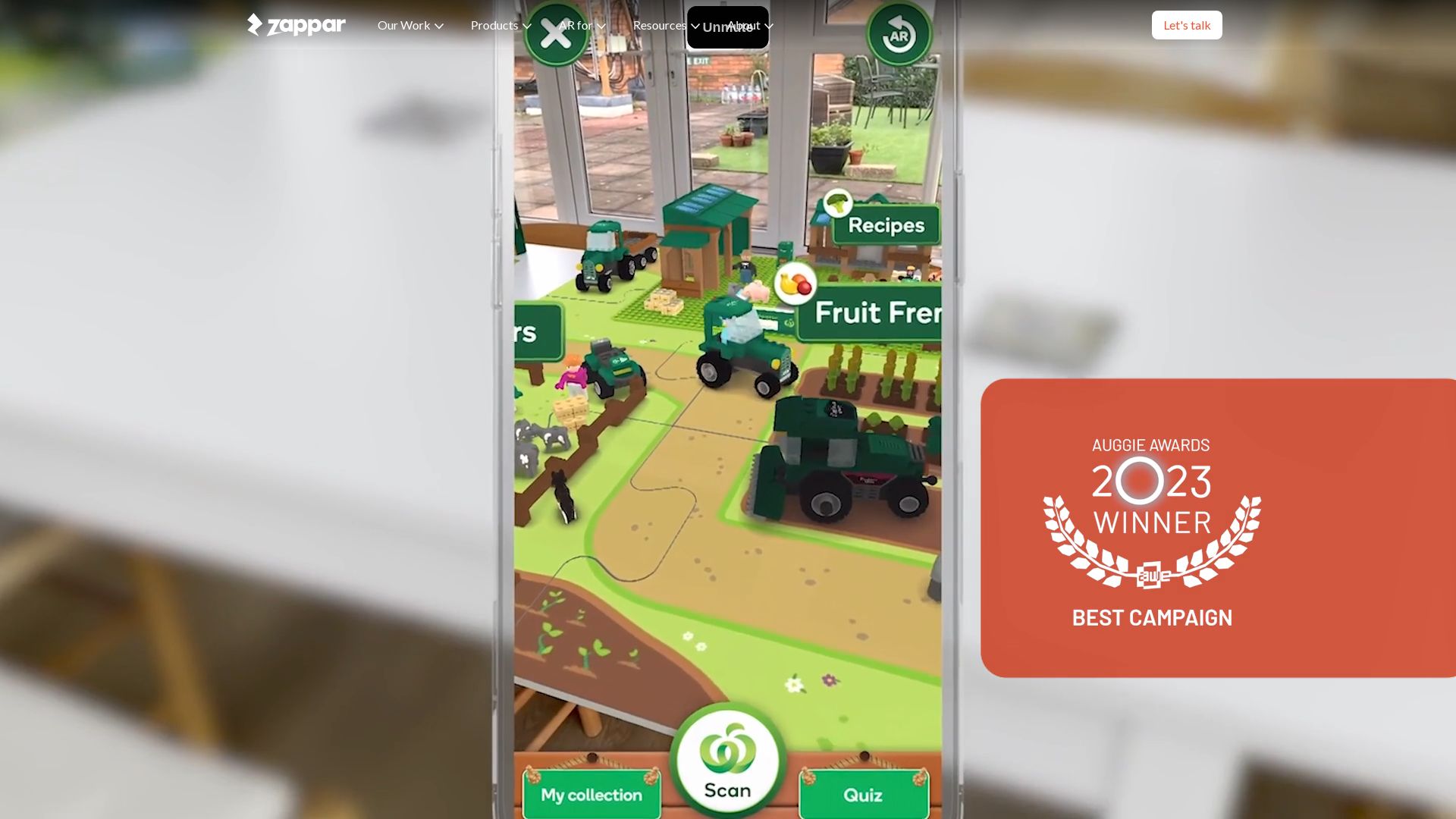
Behold, Zappar, a stalwart in the ever-evolving field of Augmented Reality. With over 12 years of ceaseless innovation, this XR platform and creative studio offers an end-to-end camera strategy, thereby etching itself in stone as a leader in the AR applications space.
Zappar Top Features
- Comprehensive XR solution dedicated to content creation, meticulous management and seamless publishing.
- ZapWorks, a toolset armory for forging AR experiences. Its recent 6th version launch only solidifies its status.
- ZapWorks Studio’s efficient creation of 3D artifacts for interactive programs showcases Zappar’s raison d’etre well.
- A user library teeming with 3D artifacts with the charm of a drag-and-drop mechanism simplifies the creation of AR experiences.
| Feature | Benefit |
|---|---|
| Integration with Sketchfab’s 3D model library | Offers users a plethora of 3D models to work with |
| Zappar’s mobile web support feature | Enables app-less AR experiences, broadening its reach |
| World and facial tracking | Enhances user interaction with AR content |
Zappar Limitations
- AR experiences can only be accessed via the Zappar App on iOS and Android, which could limit reach in some instances.
- The mobile web support feature is still in the beta phase and may have unpredictabilities.
Zappar Use Cases
Packaging
Enrich the unboxing experience and transform packaging with Zappar’s AR technology so that products recount their tales in three dimensions.
Marketing
Empower marketing campaigns with an added layer of interactivity.
Learning and Development
Leverage AR for immersive learning experiences that resonate with students in an unprecedented way.
Augment

Welcome to the digitally-enriched world of Augment, a transformative platform rooted in the growing soil of Augmented Reality (AR). Delightfully bridging the gap between the tangible and the digital, Augment spotlights the endless possibilities inherent in our everyday life through the lens of cutting-edge technology.
Augment Top Features
- Real-world application: Augment overlays perceptual data onto your environment, adding depth and insight to your interactions with the physical world.
- Hardware integration: With its hardware versatility, Augment reaches audiences through various mediums such as smartphones, tablets, and augmented reality glasses.
- Adaptable: Augment accommodates diverse AR types (marker-based and marker-less), catering to specific requirements within varied contexts.
| Features | Description |
|---|---|
| Employee training | Augment ensures accelerated learning and comprehension by integrating AR into corporate training procedures. |
| Grounded in Industry 4.0 | Augment aligns with the fourth industry revolution through its integration within a cloud-connected ecosystem, covering big data and automation. |
Augment Limitations
- Despite its advantages, AR technology, including Augment, still requires substantial hardware components like a processor, sensors, a display, and input devices.
- The AR experience offered by Augment, while more immersive than traditional digital interaction, differs from the total simulation provided by Virtual Reality.
Augment Use Cases
Use Case 1: Retail
Augment weaves its AR magic into retail, allowing consumers to visualize products in their own environments before making a purchase.
Use Case 2: Education
Augment brings educational visuals to life, enabling users to view 3D images of body systems for medical training, thus deepening learning journeys.
Use Case 3: Industrial Manufacturing
Augment enhances collaboration and safety measures in industries, making products and equipment more user-friendly and accessible.
Wikitude

Embarking its journey in 2008, Wikitude from Salzburg, Austria, transitioned from offering location-based AR experiences with their World Browser App to unlocking possibilities with their Software Development Kit (SDK). Acquired by Qualcomm in 2021, the SDK provides functionalities, versatility, and a foundation for image recognition & tracking, 3D model rendering, video overlay, location-based AR and SLAM (Simultaneous Localization And Mapping). It is compatible with Android, iOS, and Windows and optimized for smart eyewear devices.
Wikitude Top Features
- SLAM: Launched in 2017 for object recognition and tracking, markerless instant tracking.
- Image recognition: Introduced in 2012 for AR triggering, high-end image tracking within the app.
- Multiple trackers: Merges Positional Tracking with Object and Image Tracking.
- SDK 9.0: Introduced in 2020 with an expert edition for Unity experts offering advanced AR features and high-performing AR solutions.
- Object tracking: Capable of tracking identical and different objects simultaneously.
Wikitude Advantages
| Support for AR Foundation | From Unity, object visualization in Unity Editor. |
| Platform Compatibility | Optimized for Android, iOS, Windows, and smart eyewear devices. |
| Recognition Capabilities | Image recognition, object tracking, cylinder tracking, multiple object tracking. |
Wikitude Limitations
- Dependent on GPS/Wi-fi for geolocation, leading to debates over accuracy.
- Requires compass and accelerometer for image/object placement on screen.
- SLAM and other advanced features restricted to higher versions (like SDK 9.0 Expert Edition).
Wikitude Use Cases
Use case 1: App Development
For developers venturing into AR-fueled app development, Wikitude’s SDK, especially the 9.0 Expert Edition, can serve as a comprehensive tool in progressing and refining their app’s AR functionalities.
Use case 2: Gaming Industry
In the budding field of AR gaming, Wikitude offers the power and versatility required to build immersive and interactive gaming experiences.
Use case 3: Interactive Education
Educational institutions or EdTech startups looking to incorporate AR for transformative learning experiences can harness the broad-ranging capabilities of Wikitude’s SDK.
Camera IQ
The AR development platform Camera IQ provides a comprehensive suite for the creation and measure of augmented campaigns. Renowned for its integration with multiple social platforms and analytics performance tracking, it has driven AR engagement in diverse sectors, from media to retail.
Camera IQ Top Features
- AR effects support: Offers within TikTok’s Effect House and spaces like Facebook, Instagram and Snapchat.
- Proprietary analytics: Enables performance and virality tracking to optimise campaign effectiveness.
- Simplification of AR creation: 3D tools and real-time previews make your AR experience design more manageable.
- Product translation: Camera IQ allows brands to convert products into camera-friendly visuals, enhancing audience engagement.
| Feature | Benefit |
|---|---|
| Augmented Reality Service applications | Drives 5G adoption, enhances retail shopping experiences and product try-ons. |
| Virtual Try-On Composer | Enables creation of AR experiences without coding and offers curated AR experience templates. |
| Camera democratization | It aids customer base and product tier expansion. |
Camera IQ Disadvantages
- Lack of transparency in pricing details and specific user reviews or ratings.
- Dependant on integration platforms for AR support and features.
- Growth acceleration is required, especially in market targeting, customer lifetime value calculations, and market sizing.
Camera IQ Use Cases
Use case 1: AR in Media & Advertising
Camera IQ’s platform is a dynamic tool for media and marketing sectors. Partnership with Cartoon Network yielded the ‘Garnet Glasses’ effect, obtaining over 4 million views and 14,000 fan posts. AR enhances brand engagement and could boost conversion probability by up to 250%.
Use case 2: AR in Retail
AR enriches shopping experiences, with Camera IQ offering tools for virtual product try-ons. This immersion heightens consumer engagement and consequently, conversion rates.
Use Case 3: AR in Game Development
With companies like EA as clients, Camera IQ captures the burgeoning opportunity in game engines. It provides easy-to-use tools to create AR campaigns that suit this dynamic, immersive platform.
JigSpace
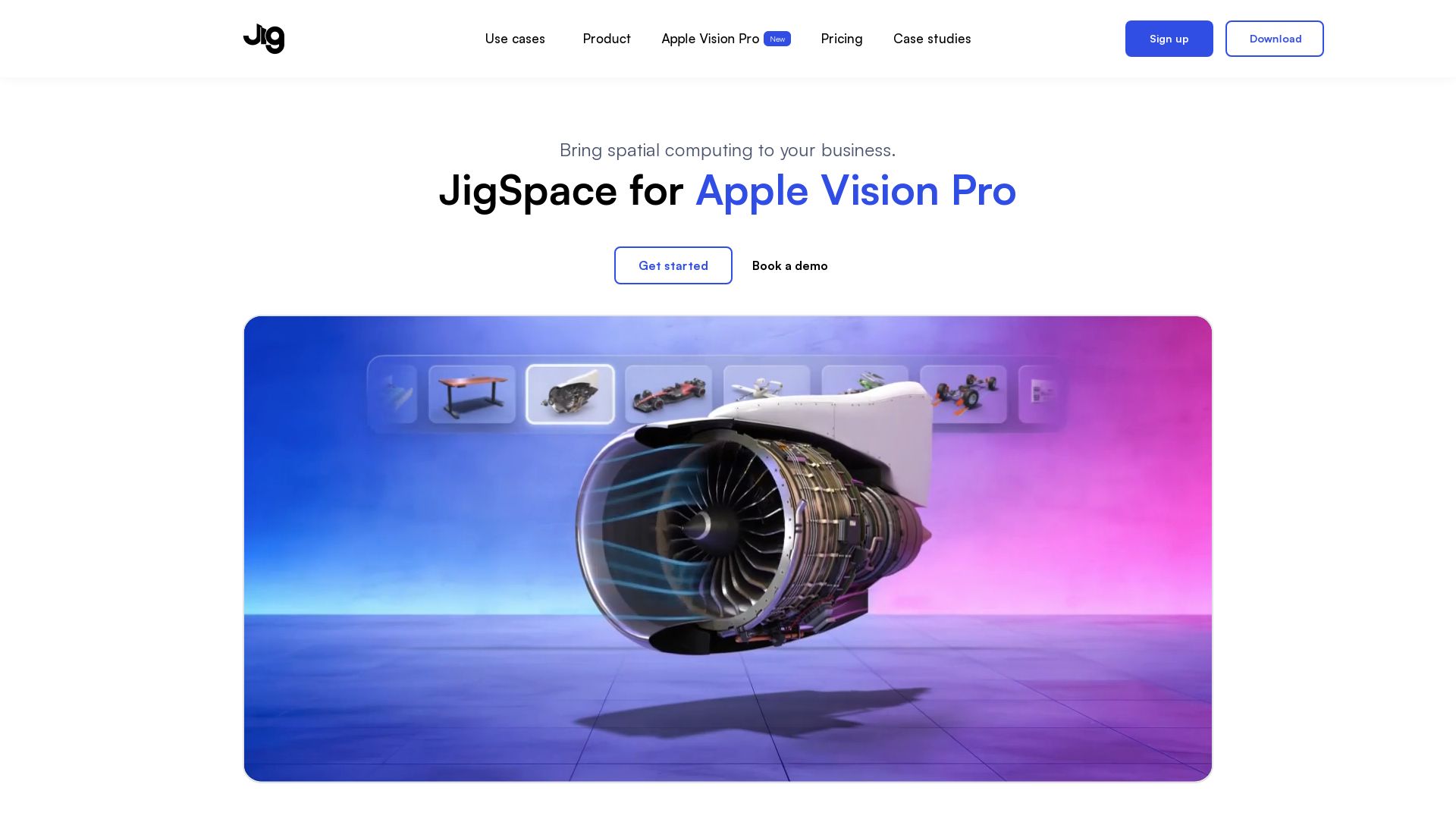
JigSpace has established itself as a leader in next-gen AR product presentations, revolutionizing the way innovators communicate their products. Notoriety followed as JigSpace featured in Apple Vision Pro announcement and its app was the highest rated on iPhone 12 launch keynote.
JigSpace Top Features
- •Ability to create engaging AR product presentations with features like zoom and walk-around.
- •Possibility of expansive reach as there are no physical limitations to product presentations.
- •Compatibility with cross-platforms, Mac and Windows, and viewable on any device.
- •Custom branding features that resonate with the company’s identity.
- •Secure in an enterprise-grade, SOC 2 Type II environment.
- •Integrated with the JavaScript library Three.js that enables creation of 3D graphics in browsers.
- •Offers a variety of supported effects, animations, objects, materials and can import/export in several formats.
| Major Feature | Description/Usage |
|---|---|
| Product Application | Primarily used for sales pitches, trade shows, product training. |
| Animation Types | Utilizes armatures, forward/inverse kinematics, morph, keyframe animations. |
| Materials | Offers materials from Lambert to Phong, smooth shading and textures. |
JigSpace Downsides
Since the company summary does not mention any downsides of JigSpace, this section cannot be populated with a verified list of limitations or disadvantages.
JigSpace Pricing
There’s no explicit mention of JigSpace’s pricing structure in the company summary. For more specific pricing details, you are advised to directly consult its official website or contact their service team.
JigSpace Use Cases
Use case 1
Product Training: With its advanced AR presentations, JigSpace enhances product understanding, thereby effectively eliminating lengthy product explanations.
Use case 2
Sales Pitches: The tool has been substantively used to assist in the closing of multimillion-dollar sponsorship deals by providing impressive AR depictions of products.
Use case 3
Brand Promotion: As vouched for by Stefano Battiston, Head of Marketing & Communications, Alfa Romeo F1, and Mike King (GM, Triangle Waterquip), the tool offers cost-effective means via virtual transportation, strengthening brand value.
Logan Bellbrook
Content writer @ Aircada with a knack for nature & AR/VR/XR. Blogging the intersection of tech & terrain.



